Jobs People Good at Origami and Building
Tornados, earthquakes and explosions often trap dazed and injured people beneath fallen buildings and other debris. Rescuers may have trouble sorting through that rubble to safely locate survivors. Invariably, there will be at least some small spaces within that debris. They may be too tiny for humans to fit through. But they're not too small for some robots.
Such rescue automatons must be very tiny. It would help if they could squeeze and bend, too, to squish through small cracks and crevices. Indeed, such robots might take a lesson or two from critters in the living world — such as cockroaches.
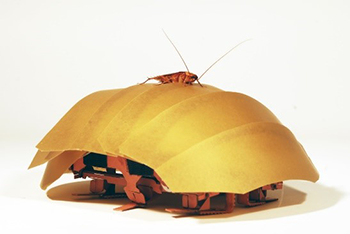
The CRAM robot was inspired by a roach, such as the American cockroach sitting on top of this one.
Tom Libby, Kaushik Jayaram and Pauline Jennings. Courtesy of PolyPEDAL Lab UC Berkeley
A few years ago, two researchers actually developed a robo-roach. They named it CRAM. Its name suggests how the robot can move through tiny spaces. And it's also an acronym. It stands for "compressible robot with articulated mechanisms," meaning it has bendable joints.

Educators and Parents, Sign Up for The Cheat Sheet
Weekly updates to help you use Science News for Students in the learning environment
Thank you for signing up!
There was a problem signing you up.
Kaushik Jayaram was a co-creator of the robot while a graduate student at the University of California, Berkeley. It certainly helped that this biologist had a background in robotics. Today, he works in Cambridge, Mass., at Harvard University's Wyss Institute for Biologically Inspired Engineering.
Clearly, the insect world inspired his design. But so did origami (Or-ih-GAH-mee), the Japanese art of paper folding. And math.
In the design of something like robo-roach (or other critter-inspired robots), researchers "use a lot of math," Jayaram says. "We combine physics and math to figure out what the robots need to do."
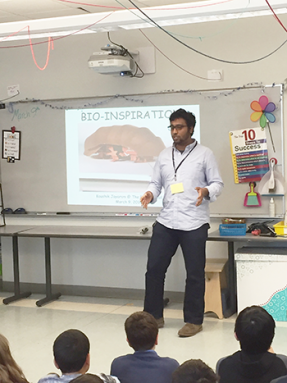
Kaushik Jayaram discusses his robo-roach research with a group of young students.
K. Jayaram
Gravity, friction and other forces slow or limit the movement of robots. The computer-controlled devices must use energy to overcome such forces. Jayaram uses one type of math (algebra) to compute the force that will act on his robots — and, therefore, how much energy those robots will need to carry out their tasks.
For CRAM, Jayaram used a second type of calculations — geometry, the math of shapes — to figure out the range of motion that each of his robot's joints will need. That has allowed him to help the robot perform a gymnastic feat known as sprawling.
"We can kind of make the robot do a split," he says. Doing splits helps these mini-robots navigate through tiny spaces, he explains.
Jayaram is just one of many researchers who are combining math and origami techniques to create clever, new products.
Watch a video about the CRAM cockroach robot.
The rules of origami
When they hear the word "origami," most people envision designs made from a single square of paper. Maybe it's a simple box, a paper crane or an elaborate dragon. Cutting is usually not allowed. So unfolding one of these designs returns the creation to the original square of paper.
But some types of origami may break one or both of the rules of folding uncut, single sheets of paper.
Origami artist Robert Lang started folding when he was six years old. At first, he copied patterns he found in books. By age 10, he was creating unique designs.
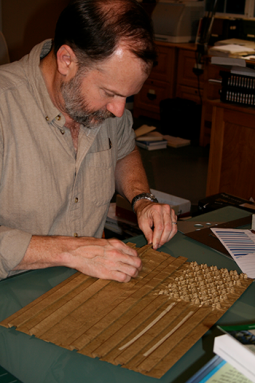
Robert Lang folds an intricate piece in his studio in Alamo, Calif.
Diane Lang
But this art wasn't Lang's first career. He trained as a physicist and engineer. Eventually, he got a job researching lasers at NASA's Jet Propulsion Laboratory in Pasadena, Calif.
His career began to morph after he decided to write a book on paper folding. It provided the motivation for Lang to quit his job. He thought he might return to work when the book was done. But "working in origami was really fun," he realized. And being self-employed allowed him to aid other scientists with their origami research. In the end, he says, "I sort of just never went back."
Today, Lang helps design everything from solar arrays for outer space to medical implants. And origami-inspired folding serves as the basis for these.
There are different approaches to origami. Take the modular type. Here, artists use multiple sheets of paper to create complex designs. Each individual sheet is folded into a module, or unit. These units are then folded together to create one larger design.
In another type, artists combine cutting and folding to create their designs. This variation is known as "kirigami."
"Most people consider origami and kirigami to be distinct," Lang notes. "Origami is mostly folding, with at most a few cuts, but no paper is cut away. Kirigami uses a lot of cuts. And sometimes paper is actually cut away."
Some people say origami artists don't use glue. But this is a myth, Lang notes.
Especially for work that may be exhibited, he observes, "quite a few artists (including the great master [Akira] Yoshizawa) use glue to stiffen the paper or hold parts together."
Beyond paper
Origami comes from two Japanese words — oru and kami. Together, they translate to "paper folding." Yet not all origami involves paper.
For instance, Paul Rothemund is credited with inventing a research field known as DNA origami. On his webpage, he apologizes for use of that phrase. "'DNA origami' had the feeling of 'DNA folding,'" he notes. He admits, however, that the term "is an abuse of the word." After all, no paper is involved.
Lang has a different view. "The art form called origami has many definitions," he says. "The one I prefer is: 'A form of sculpture in which folding is the primary means of creating the form.'" Here, he argues, origami does not have to be limited to paper. It might involve folding DNA, metals — even plant leaves.
Origami has even inspired scientists to tackle a vast variety of projects, from creating shape-shifting pasta to improving noise barriers for roads.
These and other origami-inspired scientific innovations are powerful because they pack a triple punch. They combine the power of science, art and math.
Lang has experienced this relationship firsthand throughout more than 40 years of folding. He's combined his artistic and math skills to create more than 700 original designs — everything from woodland animals to three-dimensional multi-pointed stars. Today, he is a leading origami master known for fashioning very complex folds.
Blueprints that focus on geometry
Most times, Lang doesn't start his origami projects with the folding.
He approaches each new design as a creative problem. Effective problem-solving usually starts with a plan. That's true for everything from writing an essay to building a house.
Crease patterns are the blueprints of origami, and Lang usually creates one of these before he's ready to make his first fold.
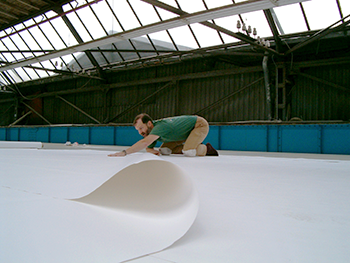
Lang folds a humungous origami piece in Dusseldorf, Germany. "Different types of designs are best folded with different types of paper," he notes. He has a paper collection he chooses from based on the size and intricacy of the object he's folding.
Courtesy of R. Lang
Before folding a three-dimensional insect, frog or dancer, for instance, he often begins by creating a mental map of what he wants to "sculpt."
That's where geometry comes in.
In his mind, he breaks down his idea for the finished art piece into the many shapes that will make it up. A butterfly, for instance, might be broken down into its wings, antennae and more. He then thinks about what shape might best represent each body part.
A transformation now takes place.
Instead of a body and legs, the proposed artwork becomes "a collection of shapes," Lang explains. When it's time to draw this collection of shapes on paper, he uses a technique called polygon packing. Polygons are two-dimensional shapes that have three or more straight sides. Packing, here, refers to finding the best way to arrange all of these many shapes onto a single sheet of paper.
The process isn't always obvious.
For very complex animals, such as an armadillo, "I can't really hold it all in my head," Lang notes. So he starts with just a few parts. He determines what shapes he'll use to represent those. He then draws that small collection of parts. Once he's done, he moves on to creating a mental map for the rest of the armadillo's body. He then adds crease lines to each shape. Only now is he ready to start folding.
Then comes the math
Lang also folds complex, abstract objects, including tessellations (Tess-eh-LAY-shuns). These are groups of shapes that fit closely together. There aren't any gaps between them. And they don't overlap. The shapes that make up tessellations are often polygons.
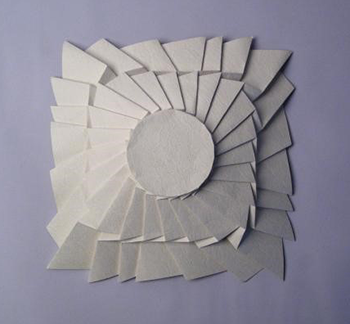
In 2007, Robert Lang folded this origami piece, which he calls "Rings4, Opus 653" from a single, irregular sheet of vellum paper. Vellum is a type of fine parchment paper. The crease pattern for Rings 4, Opus 653 was computed using Mathematica. This piece is an example of a tessellation, or a group of shapes (especially polygons) that are closely fitted together in a repeated pattern. In tessellations, these shapes are spaced so that there aren't gaps between them and they don't overlap.
Artist Robert J. Lang
To make crease patterns for these objects, Lang often works with a computer program (called Mathematica). Using that program, he writes computer code to describe each shape that will make up the object he wishes to fold.
Much of the code he writes relies on formulas from geometry, trigonometry and linear algebra, he notes. Trigonometry is the math of triangles. It focuses on relationships between the three sides of these shapes, as well as the three angles found within these shapes. Algebra is a type of math that uses symbols called variables — such as x's and y's. The equation 5 + x = 7 is an example. (To find the answer, just subtract 5 from both sides. Then you have x = 2.) Linear algebra is an advanced field of math that is typically studied in college. It focuses on equations that have two variables in them, such as an x and a y. When plotted on a graph, these equations form a straight line.
Once Lang has written his code, the computer solves any math problems in it. The computer program then generates a crease pattern for the object he'll fold.
As a kid, Lang liked math. "I thought math might have even been my primary career," he notes. As he explored his interests in college, he decided to study electrical engineering and applied physics. He was drawn to these fields because they combine math and "the joy of making things."
However, he notes, even folks who find math challenging or frustrating can become origami-inspired scientists.
Conquering fractions
Today Brandi Shaw is a chemical engineer. But the path she took to this math-centric job was far from a straight one.
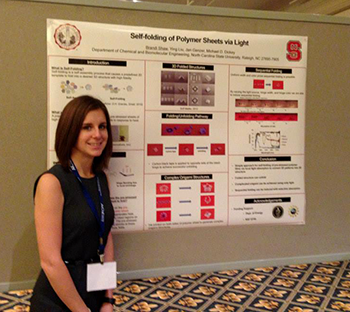
Brandi Shaw presents her team's research on self-folding polymer sheets at the 2013 American Institute of Chemical Engineers National Conference in San Francisco, Calif.
Courtesy of Brandi Shaw
She recalls struggling horribly in middle school with math — especially with fractions. Yet they were far from her only challenge. "I actually failed seventh grade. Flat out failed it," she recalls. "No summer school – repeated the whole thing," she explains.
At the time, she notes, "I had a difficult home life . . . and I completely lost interest in school. I didn't do my work. And I suffered the consequences."
Eventually, she returned to school, determined to succeed. In the years following that wake-up call, she focused on her studies. She went on to place in the top 10 of her high-school graduating class.
She used her experience hurdling obstacles to fuel her path toward a college degree. She studied at North Carolina State University in what she describes as "one of the best chemical-engineering programs in the country."
Michael Dickey was one of her first instructors in the field. During class, he discussed research opportunities for college students. Shaw itched for a taste of doing research, so she "got up the guts" to ask Dickey how she could get involved.
"It took a lot of courage," she says. But asking paid off. Shaw became part of a team that used origami-inspired techniques to create sheets made of some plastic or other polymer. The idea is to make something that will self-fold in a controlled, multi-step process to form a desired shape.
Designs are first printed on the polymer with several colors of ink. These printed lines form printed hinges — the equivalent to crease lines on paper. Each ink responds to a different color of light. The researchers described their approach, last year, in a paper in Science Advances.
Explainer: What are polymers?
An ink that is cyan (SY-an) — or green-blue — absorbs about 80 percent of red light at a wavelength of 660 nanometers (nm). Yellow ink absorbs almost no red light. The result is that cyan hinges fold in response to red light, while yellow hinges are unaffected. The reverse happens when 470 nm blue light shines onto the polymer.
By exposing the polymer sheets to different colors of light at different times, the team controls when each fold takes place. As the polymer absorbs a color of light at one of the hinges, that section of the polymer heats up. The result? That part of the polymer contracts and folds inward. How much it folds depends on the width of the hinge printed onto the polymer.
The team learned how to control the final folded shape of each polymer sheet. In this way, they created everything from nested boxes to 3-D flowers. There are other approaches for folding these sheets into different shapes. But they don't give researchers much control over the timing of the folds, the team noted in its 2017 paper.
That control is a valuable part of their process, because this folding with lights isn't just for fun. One day, it might be used to create medical devices. Or it could make products that can be shipped more easily. Flattened products could be sent to customers. Then light could be used to assemble them into their final form. Products built this way also might be easily unfolded in one place and then reassembled elsewhere.
But many of these applications won't be successful if researchers can't control the order in which parts assemble.
Shaw graduated from college in 2014. She has a reassuring message for anyone who wants to become a scientist but has been told science might not be for them. "If you're interested in it, it's for you," she says.
Story continues below video.
Origami inspires bone repairs
Like Shaw, Gulden Camci-Unal is a chemical engineer. She works at the University of Massachusetts in Lowell. But unlike Shaw, her work doesn't focus on light. Camci-Unal develops biomaterials. Someday, the ones she creates may be used to repair or even regenerate bone, heart muscle, blood vessels, skin and more.
For her bone research, she grows cells called osteoblasts on origami-folded paper. As they grow, these bone cells deposit minerals onto the paper.
She hopes to use these paper-cell combinations as implants. Her research has already shown that the implants aren't likely to be rejected by the body's immune system. Still, more work needs to be done before they are ready to help patients.
Recently, Camci-Unal has focused on making the paper part of the implant stronger. And she has investigated different ways that the paper might be broken down in the body once the bone part of the implant is in place.
In the future, such implants might be used to help people who have injuries. Lab-grown parts could repair or replace damaged bones. They might also help people whose bones didn't grow properly. "This approach can be useful for patients with bone defects of irregular sizes and shapes," explains Camci-Unal.
She uses math to evaluate certain properties of her materials. For instance, she might calculate how strong these lab-grown bones are. And she might calculate how quickly they break down.
"As a child, I loved math," Camci-Unal recalls. "I was good at it, I thought it was easy to learn and it was fun." She also enjoyed folding origami creations and marveled "at the fact that paper, a very simple material, can make such versatile and intricate structures."
"For as long as I can remember, I always wanted to be in engineering and medicine fields," she says. "I was so intrigued about different ways that engineers and doctors impact everyday life."
Classroom questions
From Jayaram's robo-roaches to Camci-Unal's paper-and-bone combinations, origami-inspired research is driving thrilling innovations.
For anyone who is interested in pursuing a career in one of these exciting fields, Camci-Unal recommends that they "stay curious and explore different subjects." She advises people to take different types of classes and to "figure out what their passion is." Then they should use every chance, she says, to expose themselves to different aspects of careers in STEAM — science, technology, engineering, art and mathematics.
Power Words
More About Power Words2-D Short for two-dimensional. This term is an adjective for something in a flat world, meaning it has features that can be described in only two dimensions — width and length.
3-D Short for three-dimensional. This term is an adjective for something that has features that can be described in three dimensions — height, width and length.
abstract Something that exists as an idea or thought but not concrete or tangible (touchable) in the real world. Beauty, love and memory are abstractions; cars, trees and water are concrete and tangible.
acronym A word made by combining some of the starting letter or groups of letters from a number of words. For instance, STEM is an acronym for Science, Technology, Engineering and Math. Radar is an acronym for RAdio Detection And Ranging. Even laser is an acronym for Light Amplification by Stimulated Emission of Radiation.
algebra A field of mathematics that describes a way to think about certain relationships that will involve numbers. And not just any particular number, usually, but abstract expressions involving numbers. For instance, instead of saying "1 + 2 = 3" or "3 – 1 = 2," algebra gives each number a letter to take its place. So it now reads something like "a + b = c" or "c - a = b." But any number can substitute for those letters as long as the values on each side of the equal sign are still true. In other words, the "a" can be a 100 and "b" can be 101 as long as c = 201. Such expressions with different things on either side of an equals sign are known as algebraic equations.
angle The space (usually measured in degrees) between two intersecting lines or surfaces at or close to the point where they meet.
application A particular use or function of something.
array A broad and organized group of objects. Sometimes they are instruments placed in a systematic fashion to collect information in a coordinated way. Other times, an array can refer to things that are laid out or displayed in a way that can make a broad range of related things, such as colors, visible at once. The term can even apply to a range of options or choices.
articulated A term for parts of some object that are connected by joints. Those joints allow movement. The fingers of a human hand are articulated with joints that allow each digit to bend a little or a lot. This allows the hand to grasp or flick or punch at something.
automaton A mechanical machine or device that can function based on predetermined, computer-controlled behaviors. Some of these may resemble a person in shape, function or tasks. However, as a machine it would work in a mechanical way, often with no sign of emotion.
biology The study of living things. The scientists who study them are known as biologists.
blood vessel A tubular structure that carries blood through the tissues and organs.
cell The smallest structural and functional unit of an organism. Typically too small to see with the unaided eye, it consists of a watery fluid surrounded by a membrane or wall.
chemical A substance formed from two or more atoms that unite (bond) in a fixed proportion and structure. For example, water is a chemical made when two hydrogen atoms bond to one oxygen atom. Its chemical formula is H2O. Chemical also can be an adjective to describe properties of materials that are the result of various reactions between different compounds.
chemical engineer A researcher who uses chemistry to solve problems related to the production of food, fuel, medicines and many other products.
code (in computing) To use special language to write or revise a program that makes a computer do something.
computer program A set of instructions that a computer uses to perform some analysis or computation. The writing of these instructions is known as computer programming.
debris Scattered fragments, typically of trash or of something that has been destroyed. Space debris, for instance, includes the wreckage of defunct satellites and spacecraft.
develop To emerge or come into being, either naturally or through human intervention, such as by manufacturing.
DNA (short for deoxyribonucleic acid) A long, double-stranded and spiral-shaped molecule inside most living cells that carries genetic instructions. It is built on a backbone of phosphorus, oxygen, and carbon atoms. In all living things, from plants and animals to microbes, these instructions tell cells which molecules to make.
engineer As a verb, to engineer means to design a device, material or process that will solve some problem or unmet need.
engineering The field of research that uses math and science to solve practical problems.
equation In mathematics, the statement that two quantities are equal. In geometry, equations are often used to determine the shape of a curve or surface.
field An area of study, as in: Her field of research was biology. Also a term to describe a real-world environment in which some research is conducted, such as at sea, in a forest, on a mountaintop or on a city street. It is the opposite of an artificial setting, such as a research laboratory.
force Some outside influence that can change the motion of a body, hold bodies close to one another, or produce motion or stress in a stationary body.
friction The resistance that one surface or object encounters when moving over or through another material (such as a fluid or a gas). Friction generally causes a heating, which can damage a surface of some material as it rubs against another.
fuel Any material that will release energy during a controlled chemical or nuclear reaction. Fossil fuels (coal, natural gas and petroleum) are a common type that liberate their energy through chemical reactions that take place when heated (usually to the point of burning).
geometry The mathematical study of shapes, especially points, lines, planes, curves and surfaces.
graduate student Someone working toward an advanced degree by taking classes and performing research. This work is done after the student has already graduated from college (usually with a four-year degree).
gravity The force that attracts anything with mass, or bulk, toward any other thing with mass. The more mass that something has, the greater its gravity.
immune system The collection of cells and their responses that help the body fight off infections and deal with foreign substances that may provoke allergies.
implant A device manufactured to replace a missing biological structure, to support a damaged biological structure, or to enhance an existing biological structure. Examples include artificial hips, knees and teeth; pacemakers; and the insulin pumps used to treat diabetes. Or some device installed surgically into an animal's body to collect information on the individual (such as its temperature, blood pressure or activity cycle).
innovation (v. to innovate; adj. innovative) An adaptation or improvement to an existing idea, process or product that is new, clever, more effective or more practical.
insect A type of arthropod that as an adult will have six segmented legs and three body parts: a head, thorax and abdomen. There are hundreds of thousands of insects, which include bees, beetles, flies and moths.
literally A term that the phrase that it modifies is precisely true. For instance, to say: "It's so cold that I'm literally dying," means that this person actually expects to soon be dead, the result of getting too cold.
mechanism The steps or process by which something happens or "works." It may be the spring that pops something from one hole into another. It could be the squeezing of the heart muscle that pumps blood throughout the body. It could be the friction (with the road and air) that slows down the speed of a coasting car. Researchers often look for the mechanism behind actions and reactions to understand how something functions.
middle school A designation for grades six through eight in the U.S. educational system. It comes immediately prior to high school. Some school systems break their age groups slightly different, including sixth grade as part of elementary school and then referring to grades seven and eight as "junior" high school.
mineral Crystal-forming substances that make up rock, such as quartz, apatite or various carbonates. Most rocks contain several different minerals mish-mashed together. A mineral usually is solid and stable at room temperatures and has a specific formula, or recipe (with atoms occurring in certain proportions) and a specific crystalline structure (meaning that its atoms are organized in regular three-dimensional patterns).
module A set of standardized parts or independent units used to assemble a more complex structure. The module could be used to create a "prefabricated" home or furniture — or even a spacecraft.
morph Short for metamorphosis, it means to change from one form to another (such as from a caterpillar to a butterfly). Or it can mean to evolve or mutate, where one or more parts of the genome undergo some sort of change in their chemistry — and potentially in their function.
muscle A type of tissue used to produce movement by contracting its cells, known as muscle fibers. Muscle is rich in protein, which is why predatory species seek prey containing lots of this tissue.
NASA Short for the National Aeronautics and Space Administration. Created in 1958, this U.S. agency has become a leader in space research and in stimulating public interest in space exploration. It was through NASA that the United States sent people into orbit and ultimately to the moon. It also has sent research craft to study planets and other celestial objects in our solar system.
navigate To find one's way through a landscape using visual cues, sensory information (like scents), magnetic information (like an internal compass) or other techniques.
origami The traditional Japanese art of paper folding. It starts with a flat sheet of paper. Through folding — and no cutting — the paper can be carefully folded into decorative 3-D structures, such as a bird in flight.
osteoblast The type of cell used by the body to make new bone tissue.
physics The scientific study of the nature and properties of matter and energy. Classical physics is an explanation of the nature and properties of matter and energy that relies on descriptions such as Newton's laws of motion. A scientist who works in such areas is known as a physicist.
polygon A two-dimensional (and therefore flat) shape with three or more sides.
polymer A substance made from long chains of repeating groups of atoms. Manufactured polymers include nylon, polyvinyl chloride (better known as PVC) and many types of plastics. Natural polymers include rubber, silk and cellulose (found in plants and used to make paper, for example).
primary An adjective meaning major, first or most important.
propulsion The act or process of driving something forward, using a force. For instance, jet engines are one source of propulsion used for keeping airplanes aloft.
range The full extent or distribution of something. For instance, a plant or animal's range is the area over which it naturally exists.
robot A machine that can sense its environment, process information and respond with specific actions. Some robots can act without any human input, while others are guided by a human.
technology The application of scientific knowledge for practical purposes, especially in industry — or the devices, processes and systems that result from those efforts.
tesselation A two-dimensional mosaic created by fitting together one (or perhaps a few) general shapes such that each shape shares each of its edges with some neighbor. There can be no overlaps of the shapes nor even minimal gaps between the shapes making up this pattern.
tornado A violently rotating column of air extending from the ground to a thunderstorm above.
trigonometry A field of mathematics that relates values having to do with the sides and angles of triangles and other geometric shapes.
unique Something that is unlike anything else; the only one of its kind.
variable (in mathematics) A letter used in a mathematical expression that may take on different values.
wavelength The distance between one peak and the next in a series of waves, or the distance between one trough and the next. Visible light — which, like all electromagnetic radiation, travels in waves — includes wavelengths between about 380 nanometers (violet) and about 740 nanometers (red). Radiation with wavelengths shorter than visible light includes gamma rays, X-rays and ultraviolet light. Longer-wavelength radiation includes infrared light, microwaves and radio waves.
Citations
Journal: Y. Liu et al. Sequential self-folding of polymer sheets. Science Advances. Vol. 3, March 3, 2017, p. e1602417. doi: 10.1126/sciadv.1602417.
Journal: G. Camci-Unal et al. Biomineralization guided by paper templates. Scientific Reports. Vol. 6, June 9, 2016, No. 27693. doi: 10.1038/srep27693.
Journal: K. Jayaram and R. Full. Cockroaches traverse crevices, crawl rapidly in confined spaces, and inspire a soft, legged robot. Proceedings of the National Academy of Sciences. Volume 113, February 23, 2016, p. E 950. doi: 10.1073/pnas.1514591113.
See more of Robert Lang's origami creations.
Wordfind
Jobs People Good at Origami and Building
Source: https://www.sciencenewsforstudents.org/article/cool-jobs-paper-folding-origami-inspiring-science
0 Response to "Jobs People Good at Origami and Building"
Publicar un comentario